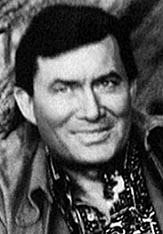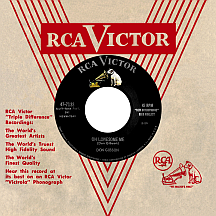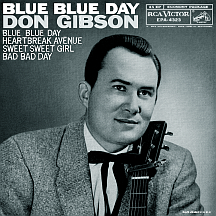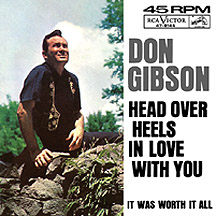DON GIBSON
If you happen to find yourself in one of those "blue-blue-day-heartbreak-who-cares-what-about-lonesome-me" moods and you want some music to help you wallow in your depression, Don Gibson's your man. Feeling sorry for himself was Don's specialty and as a singer and songwriter he made quite a name exploring the depths of self-pity, piling up a big stack of hits in the process. Also, in a slightly less drastic mindset, he composed a couple of sad songs that found long-lasting impact in the pop culture mainstream, one through a version by a blind, multitalented rhythm and blues singer, the other by way of an unusually gifted vocalist who died before her time.
Unhappy with the demands of growing up in a family of hard-working Shelby, North Carolina sharecroppers, Don made a decision at a very young age to leave the fields at the first opportunity, dropping out of school after the second grade. Very shy as a young boy, he developed a stutter and stayed away from crowds of people. A smart child regardless of his limited schooling, he spent what spare time he had reading and listening to music on the radio. In his teens, Gibson frequented pool halls in Shelby, playing well enough to make money as a pool shark while occasionally practicing guitar with some of his friends. Ned Costner, a fiddle player from the area, thought Don (who idolized the innovative techniques of jazz great Django Reinhardt) had potential and, joined by Curly Sisk on guitar, they began playing together for friends and relatives at each other's homes. Local exposure led to performances by the trio on Selby radio station WOHS, calling themselves The Sons of the Soil with Don playing bass and singing (and gradually overcoming his shyness). Later, with a varying number of local musicians including fiddle player Jim Barber, they performer on-air as The Hi-Lighters.
Auditioning for Mercury Records in 1949 when Don was just 17 years old, producer Murray Nash liked the Sons of the Soil name, so he took them on as a vocal quartet in the style of The Sons of the Pioneers (one of the hottest groups of the day with the hits "Cool Water" and "Tumbling Tumbleweeds"). The guys split up when this venture failed and Don started a new band, The King Cotton Kinfolks, auditioning the group with Steve Sholes at RCA Victor. Very little came of this beyond a couple of singles for the label in 1951, but the group became a featured act on Tennessee Barn Dance, a widely-heard country radio show on WNOX in Knoxville, Tennessee. Columbia Records showed some interest, but Gibson's third record label affiliation did no better for him than the first two had.
He began to focus on writing songs, a career path alternative to his faltered attempts at recording. Mel Foree of Nashville's Acuff-Rose Publishing Company (owned by Roy Acuff and Fred Rose) heard him perform "Sweet Dreams," an early composition, which resulted in a songwriting contract with the publisher and a fourth label deal, this time with MGM. Faron Young's recording of the song on Capitol became a top ten country hit in the summer and fall of 1956, and Gibson's original on MGM also charted briefly. Nothing more came of his association with MGM, but he was energized by this first encounter with success as a songwriter and tackled the new challenge with gusto.
Living in a trailer in the woods near Knoxville in 1957, Gibson spent each day writing songs, sending them to Acuff-Rose for approval. At the same time, Chet Atkins, in addition to his own recording career, had taken over RCA Victor's country division, as Sholes (due to his work with Elvis Presley the previous year) was moved to the company's pop division. Atkins then made a decision that impacted country music in a big way: feeling the pressure of competition from the emerging rock and roll movement, he started producing country music using rhythm guitar, piano, bass, drums and background choruses in place of steel guitars and fiddles. The result was a more "pop" sound, criticized by old guard country purists, but it started a trend that eventually put country music into the mainstream. Don returned to the label to work with Chet and was among the first to benefit from the new production methods.
In early 1958, his second single for RCA featured two songs he'd written while isolated in that trailer. "Oh Lonesome Me" was a fast-rising hit, reaching number one country and crossing over to the top ten of the pop charts (which only a handful of country singles had previously accomplished). The flip, "I Can't Stop Lovin' You," received a great deal of airplay and also became a hit. They followed it with a rerelease of his first single for the label from the previous year, "Blue Blue Day," another country number one. The two chart-topping hits with their self-pitying (and widely relatable) themes led to his being nicknamed "The Sad Poet" and set the tone for his future success.
The next four years or so ere immensely rewarding for Gibson. He wrote many great songs, often employing the "lonesome me" angle, enjoying huge hits produced by Atkins and backed in studio sessions at different times by Floyd Cramer (who enjoyed his own run of RCA Victor hits), banjo player Hubert Davis, jazz guitarist Johnny Smith and even Brazilian guitar duo Los Indios Tabajaras (whose "Maria Elena" was a top ten hit for the label in 1963). His best selling records during that time were "Give Myself a Party" and "Look Who's Blue" in 1958, "Who Cares" and "Don't Tell Me Your Troubles" in '59, "Just One Time" in '60 and a hit rerecording of "Sweet Dreams" that same year. One of his biggest hits, "Sea of Heartbreak," wasn't composed by Gibson (it was by Hal David and Paul Hampton) but sounded like it could have been. Don's "Lonesome Number One" followed it high up on the charts in 1961.

Two of his earlier songs found their way back onto the charts in versions that would solidify Gibson's place in music history, raising the familiarity of his music to heights even his own hit singles hadn't reached. The first came when Ray Charles switched gears from R&B to country in 1962 with the enormously popular album Modern Sounds in Country and Westen Music and one of its singles, "I Can't Stop Loving You" (the flip side of Don's first major hit, minus the apostrophe in the title), given the full treatment with a large string section and pop backup singers. The song was the top-selling and most-played record of the entire year of '62 and the highlight of Ray's diverse career; recorded by many artists since, it is considered one of the most popular songs of all time. The other Gibson song that has achieved classic status did so through tragedy: Patsy Cline recorded "Sweet Dreams" (renamed "Sweet Dreams (Of You)") shortly before her death on March 5, 1963. Decca Records made it the first single release after the plane crash that also took the lives of Cowboy Copas and Hawkshaw Hawkins. It has since become closely identified with Cline and was used as the title of the popular 1985 biopic of her life and career. As with "I Can't Stop Lovin' You," exposure for "Sweet Dreams" has been substantial throughout the years.
Don could have rested on his songwriting laurels when he stopped hitting the pop charts in 1962, but in spite of the role he played in country's progression toward pop music, fans continued to embrace him and he produced a steady run of country hits all the way to the end of the '70s. Some memorable duets came from a pairing with Dottie West in 1969, including "Rings of Gold." Signing with Hickory Records in 1970, he returned to the number one spot on the country charts in '73 with "Woman (Sensuous Woman)" and had by that time broken away from the 'who cares for me?' image. Still, for many he remains the definitive sad, "Lonesome" singer. I, for one, will always reach for a few Don Gibson records when I'm having "one of those days."
NOTABLE SINGLES:
- Cloudy Skies - 1949
as the Sons of the Soil - I Love No One But You - 1951
by Don Gibson and his King Cotton Kinfolks - We're Steppin' Out Tonite - 1952
- Sweet Dreams - 1956
- Oh Lonesome Me /
I Can't Stop Lovin' You - 1958 - Blue Blue Day - 1958
- Give Myself a Party /
Look Who's Blue - 1958 - Who Cares - 1959
- Lonesome Old House - 1959
- Don't Tell Me Your Troubles - 1959
- Just One Time - 1960
- Far, Far Away - 1960
- What About Me - 1961
- Sea of Heartbreak - 1961
- Lonesome Number One - 1961
- I Can Mend Your Broken Heart - 1962
- So How Come (No One Loves Me) - 1962
- Head Over Heels in Love With You - 1963
- Anything New Gets Old (Except My Love for You) - 1963
- Cause I Believe in You - 1964
- Again - 1965
- Watch Where You're Going - 1965
- A Born Loser - 1966
- (Yes) I'm Hurting - 1966
- Funny, Familiar, Forgotten, Feelings - 1966
- All My Love - 1967
- It's a Long, Long Way to Georgia - 1968
- Rings of Gold - 1969
with Dottie West - There's a Story (Goin' 'Round) - 1969
with Dottie West - Country Green - 1971
- Woman (Sensuous Woman) - 1972
- Touch the Morning - 1973
- One Day at a Time - 1974
- Bring Back Your Love to Me - 1974




